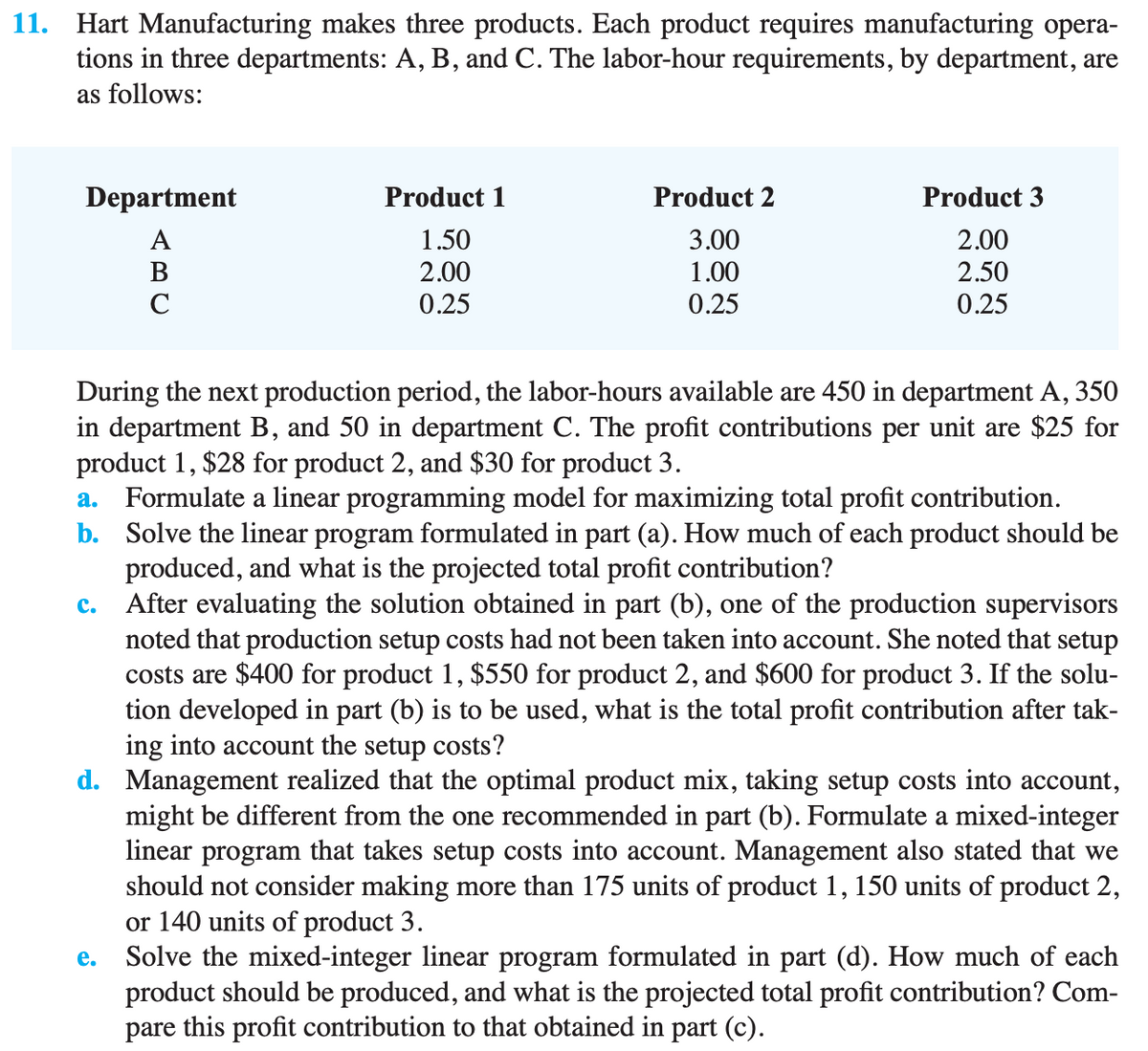11. Hart Manufacturing makes three products. Each product requires manufacturing opera- tions in three departments: A, B, and C. The labor-hour requirements, by department, are as follows: Department Product 1 Product 2 Product 3 A 1.50 3.00 2.00 B 2.00 1.00 2.50 C 0.25 0.25 0.25 During the next production period, the labor-hours available are 450 in department A, 350 in department B, and 50 in department C. The profit contributions per unit are $25 for product 1, $28 for product 2, and $30 for product 3. a. Formulate a linear programming model for maximizing total profit contribution. b. Solve the linear program formulated in part (a). How much of each product should be produced, and what is the projected total profit contribution? C. After evaluating the solution obtained in part (b), one of the production supervisors noted that production setup costs had not been taken into account. She noted that setup costs are $400 for product 1, $550 for product 2, and $600 for product 3. If the solu- tion developed in part (b) is to be used, what is the total profit contribution after tak- ing into account the setup costs? d. Management realized that the optimal product mix, taking setup costs into account, might be different from the one recommended in part (b). Formulate a mixed-integer linear program that takes setup costs into account. Management also stated that we should not consider making more than 175 units of product 1, 150 units of product 2, or 140 units of product 3. e. Solve the mixed-integer linear program formulated in part (d). How much of each product should be produced, and what is the projected total profit contribution? Com- pare this profit contribution to that obtained in part (c).
11. Hart Manufacturing makes three products. Each product requires manufacturing opera- tions in three departments: A, B, and C. The labor-hour requirements, by department, are as follows: Department Product 1 Product 2 Product 3 A 1.50 3.00 2.00 B 2.00 1.00 2.50 C 0.25 0.25 0.25 During the next production period, the labor-hours available are 450 in department A, 350 in department B, and 50 in department C. The profit contributions per unit are $25 for product 1, $28 for product 2, and $30 for product 3. a. Formulate a linear programming model for maximizing total profit contribution. b. Solve the linear program formulated in part (a). How much of each product should be produced, and what is the projected total profit contribution? C. After evaluating the solution obtained in part (b), one of the production supervisors noted that production setup costs had not been taken into account. She noted that setup costs are $400 for product 1, $550 for product 2, and $600 for product 3. If the solu- tion developed in part (b) is to be used, what is the total profit contribution after tak- ing into account the setup costs? d. Management realized that the optimal product mix, taking setup costs into account, might be different from the one recommended in part (b). Formulate a mixed-integer linear program that takes setup costs into account. Management also stated that we should not consider making more than 175 units of product 1, 150 units of product 2, or 140 units of product 3. e. Solve the mixed-integer linear program formulated in part (d). How much of each product should be produced, and what is the projected total profit contribution? Com- pare this profit contribution to that obtained in part (c).
Practical Management Science
6th Edition
ISBN:9781337406659
Author:WINSTON, Wayne L.
Publisher:WINSTON, Wayne L.
Chapter6: Optimization Models With Integer Variables
Section6.4: Fixed-cost Models
Problem 17P
Related questions
Question

Transcribed Image Text:11. Hart Manufacturing makes three products. Each product requires manufacturing opera-
tions in three departments: A, B, and C. The labor-hour requirements, by department, are
as follows:
Department
Product 1
Product 2
Product 3
A
1.50
3.00
2.00
B
2.00
1.00
2.50
C
0.25
0.25
0.25
During the next production period, the labor-hours available are 450 in department A, 350
in department B, and 50 in department C. The profit contributions per unit are $25 for
product 1, $28 for product 2, and $30 for product 3.
a. Formulate a linear programming model for maximizing total profit contribution.
b. Solve the linear program formulated in part (a). How much of each product should be
produced, and what is the projected total profit contribution?
C.
After evaluating the solution obtained in part (b), one of the production supervisors
noted that production setup costs had not been taken into account. She noted that setup
costs are $400 for product 1, $550 for product 2, and $600 for product 3. If the solu-
tion developed in part (b) is to be used, what is the total profit contribution after tak-
ing into account the setup costs?
d. Management realized that the optimal product mix, taking setup costs into account,
might be different from the one recommended in part (b). Formulate a mixed-integer
linear program that takes setup costs into account. Management also stated that we
should not consider making more than 175 units of product 1, 150 units of product 2,
or 140 units of product 3.
e.
Solve the mixed-integer linear program formulated in part (d). How much of each
product should be produced, and what is the projected total profit contribution? Com-
pare this profit contribution to that obtained in part (c).
Expert Solution
This question has been solved!
Explore an expertly crafted, step-by-step solution for a thorough understanding of key concepts.
This is a popular solution!
Trending now
This is a popular solution!
Step by step
Solved in 2 steps with 4 images

Recommended textbooks for you

Practical Management Science
Operations Management
ISBN:
9781337406659
Author:
WINSTON, Wayne L.
Publisher:
Cengage,

Practical Management Science
Operations Management
ISBN:
9781337406659
Author:
WINSTON, Wayne L.
Publisher:
Cengage,